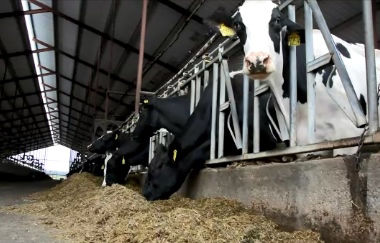The facility in the heart of northeast Texas dairy country that once collected milk from hundreds of Holstein cows, is now a depository for knickknacks, scrap wood and metal, tools and idle equipment.
Surrounding county roads are littered with similar remnants—abandoned dairy barns, empty drip sheds, exposed concrete slabs and silent stalls—from the region’s past as Texas’ top milk producing area.
Texas milk production continues to rise, said Ellen Jordan, Texas A&M AgriLife Extension Service state dairy specialist, Dallas. Dairy facilities increased production 9 percent in 2017, to more than 12 billion pounds of milk.
Texas A&M AgriLife Research and AgriLife Extension continue to help Texas dairy producers around the state develop and implement technology and methods to improve animal welfare, fertility rates and nutrition, Jordan said.
It’s likely Texas will become a top-five milk producing state in the nation this year, she said, but where that milk is produced shifted dramatically over the past four decades.
In 1980, almost 25 percent of the state’s milk was produced in northeast Texas. Hopkins County was the dairy capital of the state and produced 16 percent of the state’s 3.5 billion pounds of milk that year, or 560 million pounds, according to U.S. Department of Agriculture Agriculture Marketing Service.
By 1990, production in Hopkins County had risen to 925.6 million pounds, but was surpassed by Erath County in central Texas with almost 1 billion pounds produced. Central and northeast Texas produced 57 percent of the state’s milk by that time.
Production in northeast Texas rapidly declined over the next two decades as milk production moved west to a region that accounted for less than 1 percent of production in 1980—the Panhandle.
“There were several factors that initiated the move to Central Texas and eventually the Panhandle over the past two decades,” Jordan said. “Rainfall, animal welfare, quality of life for producers, the economics of production and other factors all contributed to the move from east Texas.”
East Texas weather, including up to 50 inches of annual rainfall, heat and humidity, presented several challenges for dairies, she said.
Rain caused problems with mud and waste management, she said.
“Dealing with multiple heavy rain events poses real problems for producers in east Texas,” she said. “Producers would have to battle mud and need additional lagoon space for waste catchment to prevent runoff and possible environmental impacts. Weather was the No. 1 issue for production quality and quantity and animal welfare.”
Heat and humidity reduce herd production significantly, including milk pounds and fertility rates, she said. It’s easier to cool cows in the summer and warm them in the winter in areas where humidity levels are low.
“The Panhandle receives around 20 inches of rainfall each year,” she said. “There are increased costs associated with humidity and the amount of rainfall in East Texas compared to what producers would deal with in drier regions of the state. Happy, healthy cows produce more milk and moving them to an environment that is better suited for them made sense.”
Quality of life for cows was an important factor in the shift, and so was quality of life for dairy producers, she said. More than 95 percent of Texas dairies are family owned and operated.
Dairy production is a year-round, around-the-clock venture, Jordan said. Dairy farmers wanted to get big enough to hire managers and enough workers so they could attend family events and take vacations as with other vocations, but expansion was costlier in east and central Texas.
Higher land values and suburban sprawl contributed to the economic decision to move west, Jordan said. Dairy operations that hoped to expand needed additional space and finding contiguous parcels meant paying premium prices for land.
Landowners also faced the increased demand to sell as encroaching development placed a premium price on their land holdings, she said.
“As a result, you saw a lot of dairy producers sell out entirely and either retire or take up beef or poultry production,” she said. “There were also many producers who retired and the next generation were not interested in continuing in the dairy business.”
For example, in the first half of the 20th Century, there were 200 dairies in operation in Dallas County, Jordan said. Today, there are none.
The Panhandle was a good option because of rainfall amounts and land availability, but it also provided a steady supply of high quality feed because of the well-established feedlot industry in the region, Jordan said.
Cottonseed, a waste product that ended up in landfills in the 1970s, emerged as a high-quality feed option for dairy producers as well, she said.
“Dairy cows like cottonseed,” she said. “Converting a waste product into a valuable food source was a win for cotton and dairy producers. Nutrition and high-quality feed is critical for milk production.”
The combination of economic, logistical and environmental factors helped the Panhandle emerge as an ideal location for dairy producers. Since the 1980s, milk production in the region boomed from less than 1 percent to more than 68 percent in 2017.
Jordan doesn’t expect that trend to change.
“The Panhandle-eastern New Mexico region is already the third largest milk producing area in the country with around 15 billion pounds of milk produced in 2017,” she said. “New technology and best management practices will only enhance the logistical and environmental side of production, which enhances the animal welfare aspect and quality of life for our producers as they work to provide quality milk to consumers.”


